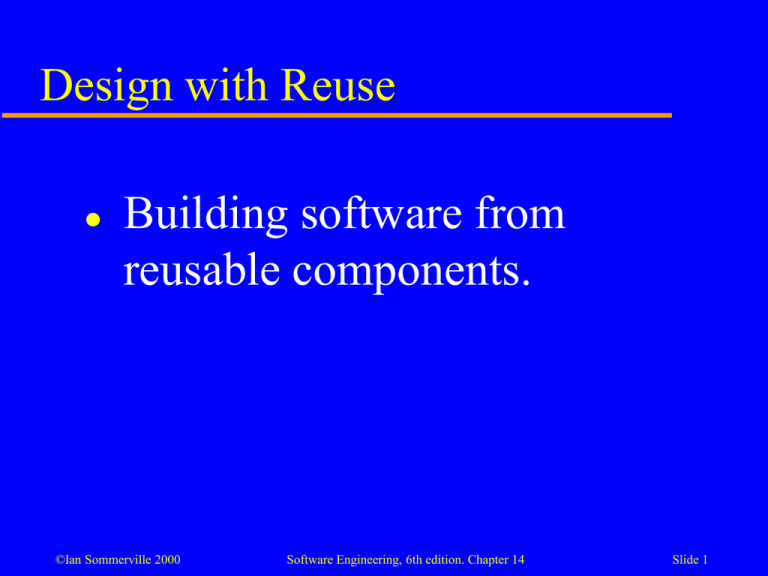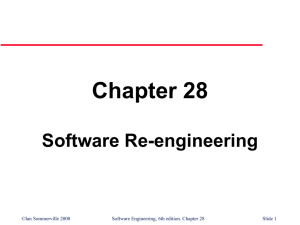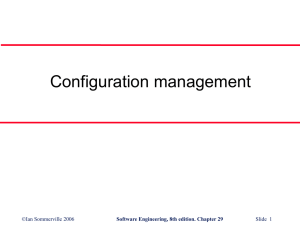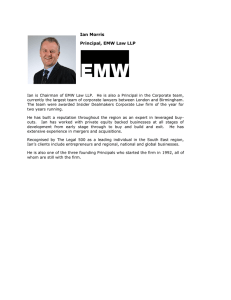Design with Reuse Building software from reusable components.
advertisement

Design with Reuse Building software from reusable components. ©Ian Sommerville 2000 Software Engineering, 6th edition. Chapter 14 Slide 1 Software reuse In most engineering disciplines, systems are designed by composing existing components that have been used in other systems Software engineering has been more focused on original development but it is now recognised that to achieve better software, more quickly and at lower cost, we need to adopt a design process that is based on systematic reuse ©Ian Sommerville 2000 Software Engineering, 6th edition. Chapter 14 Slide 4 Reuse-based software engineering Application system reuse Component reuse Function reuse ©Ian Sommerville 2000 Software Engineering, 6th edition. Chapter 14 Slide 5 Benefits of reuse Increased reliability Reduced process risk Effective use of specialists Standards compliance Accelerated development ©Ian Sommerville 2000 Software Engineering, 6th edition. Chapter 14 Slide 7 Requirements for design with reuse It must be possible to find appropriate reusable components The re-user of the component must be confident that the components will be reliable and will behave as specified The components must be documented so that they can be understood and, where appropriate, modified ©Ian Sommerville 2000 Software Engineering, 6th edition. Chapter 14 Slide 8 Reuse problems Increased maintenance costs Lack of tool support Not-invented-here syndrome Maintaining a component library Finding and adapting reusable components ©Ian Sommerville 2000 Software Engineering, 6th edition. Chapter 14 Slide 9 Generator-based reuse Program generators involve the reuse of standard patterns and algorithms These are embedded in the generator and parameterised by user commands. A program is then automatically generated Generator-based reuse is possible when domain abstractions and their mapping to executable code can be identified A domain specific language is used to compose and control these abstractions ©Ian Sommerville 2000 Software Engineering, 6th edition. Chapter 14 Slide 10 Types of program generator Types of program generator • • • Application generators for business data processing Parser and lexical analyser generators for language processing Code generators in CASE tools Generator-based reuse is very cost-effective but its applicability is limited to a relatively small number of application domains It is easier for end-users to develop programs using generators compared to other componentbased approaches to reuse ©Ian Sommerville 2000 Software Engineering, 6th edition. Chapter 14 Slide 11 14.1 Component-based development Component-based software engineering (CBSE) is an approach to software development that relies on reuse Components are more abstract than object classes and can be considered to be stand-alone service providers ©Ian Sommerville 2000 Software Engineering, 6th edition. Chapter 14 Slide 13 Components Components provide a service without regard to where the component is executing or its programming language Components can range in size from simple functions to entire application systems Components are independent – very loosely coupled Components are encapsulated ©Ian Sommerville 2000 Software Engineering, 6th edition. Chapter 14 Slide 14 Component interfaces Requires interface ©Ian Sommerville 2000 Component Software Engineering, 6th edition. Chapter 14 Provides interface Slide 15 Example: Printing services component Requires interface PrintService GetPDfile Provides interface Print GetQueue PrinterInt Remove Transfer Register Unregister ©Ian Sommerville 2000 Software Engineering, 6th edition. Chapter 14 Slide 17 Components – different levels of abstractions Functional abstraction Casual groupings Data abstractions Cluster abstractions System abstraction ©Ian Sommerville 2000 Software Engineering, 6th edition. Chapter 14 Slide 18 CBSE processes Component-based development can be integrated into a standard software process by incorporating a reuse activity in the process However, in reuse-driven development, the system requirements are modified to reflect the components that are available CBSE usually involves a prototyping or an incremental development process with components being ‘glued together’ using a scripting language ©Ian Sommerville 2000 Software Engineering, 6th edition. Chapter 14 Slide 19 An opportunistic reuse process Design system aachitecture ©Ian Sommerville 2000 Search for reusable components Incorporate discovered components Software Engineering, 6th edition. Chapter 14 Slide 20 Specify components 14.1.1 Application frameworks Frameworks are a sub-system design made up of a collection of abstract and concrete classes and the interfaces between them The sub-system is implemented by adding components to fill in parts of the design and by instantiating the abstract classes in the framework Frameworks are moderately large entities that can be reused ©Ian Sommerville 2000 Software Engineering, 6th edition. Chapter 14 Slide 23 Framework classes System infrastructure frameworks Middleware integration frameworks Enterprise application frameworks ©Ian Sommerville 2000 Software Engineering, 6th edition. Chapter 14 Slide 24 Extending frameworks Frameworks are generic and are extended to create a more specific application or subsystem Extending the framework involves • • Adding concrete classes that inherit operations from abstract classes in the framework Adding methods that are called in response to events that are recognised by the framework (call backs) Problem with frameworks is their complexity and the time it takes to use them effectively ©Ian Sommerville 2000 Software Engineering, 6th edition. Chapter 14 Slide 25 14.1.2 COTS product reuse COTS - Commercial Off-The-Shelf systems COTS systems are usually complete application systems that offer an API (Application Programming Interface) Building large systems by integrating COTS systems is now a viable development strategy for some types of system such as E-commerce systems ©Ian Sommerville 2000 Software Engineering, 6th edition. Chapter 14 Slide 28 COTS system integration problems Lack of control over functionality and performance Problems with COTS system inter-operability No control over system evolution Support from COTS vendors ©Ian Sommerville 2000 Software Engineering, 6th edition. Chapter 14 Slide 29 14.1.3 Component development for reuse Components for reuse may be specially constructed by generalising existing components Component reusability … There is a trade-off between reusability and usability. ©Ian Sommerville 2000 Software Engineering, 6th edition. Chapter 14 Slide 30 Reusable components The development cost of reusable components is higher than the cost of specific equivalents. This extra reusability enhancement cost should be an organization rather than a project cost Generic components may be less space-efficient and may have longer execution times than their specific equivalents ©Ian Sommerville 2000 Software Engineering, 6th edition. Chapter 14 Slide 31 Reusability enhancement Name generalisation Operation generalisation Exception generalisation Component certification ©Ian Sommerville 2000 Software Engineering, 6th edition. Chapter 14 Slide 32 14.2 Application families An application family or product line is a related set of applications that has a common, domainspecific architecture The common core of the application family is reused each time a new application is required Each specific application is specialised in some way ©Ian Sommerville 2000 Software Engineering, 6th edition. Chapter 14 Slide 34 Application family specialisation Platform specialisation Configuration specialisation Functional specialisation ©Ian Sommerville 2000 Software Engineering, 6th edition. Chapter 14 Slide 35 Example: A resource management system User access Add Delete Resource desc. Program access Query Browse Screen spec. Admin Report Report spec. Resource database ©Ian Sommerville 2000 Software Engineering, 6th edition. Chapter 14 Slide 36 Application family architectures Architectures must be structured in such a way to separate different sub-systems and to allow them to be modified The architecture should also separate entities and their descriptions and the higher levels in the system access entities through descriptions rather than directly ©Ian Sommerville 2000 Software Engineering, 6th edition. Chapter 14 Slide 38 A library system Library user access Add Delete Query Browse Resource desc. Admin Report Screen spec. Issue Return Users Report spec. Library holdings database ©Ian Sommerville 2000 Software Engineering, 6th edition. Chapter 14 Slide 39 Family member development Re-negotiate requirements Elicit stakeholder requirements ©Ian Sommerville 2000 Choose closestfit family member Adapt existing system Software Engineering, 6th edition. Chapter 14 Deliver new family member Slide 41 14.3 Design patterns A design pattern is a way of reusing abstract knowledge about a problem and its solution A pattern is a description of the problem and the essence of its solution – a well-tried solution to a common problem It should be sufficiently abstract to be reused in different settings Patterns often rely on object characteristics such as inheritance and polymorphism to provide generality ©Ian Sommerville 2000 Software Engineering, 6th edition. Chapter 14 Slide 43 Pattern elements Name • Problem description Solution description • A meaningful pattern identifier Not a concrete design but a template for a design solution that can be instantiated in different ways Consequences • The results and trade-offs of applying the pattern ©Ian Sommerville 2000 Software Engineering, 6th edition. Chapter 14 Slide 44 Multiple displays 50 D A 25 C A B B C D 0 Subject Observer 1 ©Ian Sommerville 2000 A: 40 B: 25 C: 15 D: 20 Software Engineering, 6th edition. Chapter 14 Observer 2 Slide 45 The Observer pattern Name • Description • Used when multiple displays of state are needed Solution description • Separates the display of object state from the object itself Problem description • Observer See Figure 14.14 with UML description and Figure 14.12 with text Consequences • Optimisations to enhance display performance are impractical ©Ian Sommerville 2000 Software Engineering, 6th edition. Chapter 14 Slide 46 Design Patterns Limitations Hard to learn Requires experienced developers ©Ian Sommerville 2000 Software Engineering, 6th edition. Chapter 14 Slide 48



